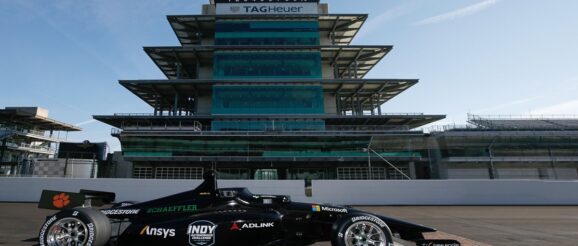Indy Autonomous Challenge Begins New Era of Innovation at IMS – The Pit Window

Photo from IMS website
The Indy Autonomous Challenge, set for October 23 at Indianapolis Motor Speedway, ushers i n a the next wave of automotive innovation. IMS used to be a proving ground for safety and other aspects of passenger vehicles. Modern racing has pushed that mostly to the side. This event, featuring autonomous vehicles, seeks to return the Speedway to its role as a developer of advanced automotive progress.
The release from IMS:
January 11, 2021 | By Indianapolis Motor Speedway
Energy Systems Network (ESN) and the Indianapolis Motor Speedway (IMS), organizers of the Indy Autonomous Challenge (IAC), today unveiled the official race car that will be autonomously driven by scores of university teams in the world’s first high-speed, head-to-head autonomous race at the Racing Capital of the World on Oct. 23, 2021.
The primary goal of the IAC is to advance technologies that can speed the commercialization of fully autonomous vehicles and advanced driver-assistance systems (ADAS), leading to increased safety and performance. In addition, the IAC is a challenging competition to excite the best and brightest university students from around the world to engage in hands-on engineering firsts.
“The Dallara-built IAC race car is the most advanced, fastest autonomous vehicle ever developed,” stated Paul Mitchell, president and CEO of ESN, and co-organizer of the IAC. “Our IAC sponsors are providing radar, lidar, optical cameras and advanced computers, bringing the value of each vehicle to $1 million.”
The IAC is scheduled for Oct. 23, 2021, at the IMS, with a qualifying simulation race during the Indy 500 week in May. The total IAC prize purse is $1.5 million: $1 million awarded to the winning team of the October IAC race, and an additional $500,000 for winners of the hackathons and simulation races, awarded by IAC sponsor, Ansys.
More than 500 undergraduate and graduate students, PhDs and mentors who excel in artificial intelligence software have responded to the challenge, representing 39 universities in 11 countries on four continents and 14 U.S. states.
Inspiration for the IAC was the DARPA Grand Challenge, as explained by 2005 winner, Sebastian Thrun: “The DARPA Grand Challenge proved that robots can drive themselves in very confined environments, but that they don’t have the agility and skill of a really well-trained human racecar driver to act in extreme situations. IMS is the best place in the world to challenge the robotics community to test self-driving cars. By going into a racing context, we will stretch self-driving cars to the absolute limit.”
The Modified Dallara IL-15 Autonomous Race Car
Since 2002, Dallara has been the sole race car supplier of the Indy Lights series, and now the modified Dallara IL-15 is the official IAC racecar.
“Dallara is the best race car engineering company in the world, yet designing the chassis for autonomous racing was really challenging,” explained Stefano dePonti, CEO and general manager of Dallara USA. “Dallara loves innovation and technological challenges, and we share the IAC’s passion for education and motorsports.”
The modified Dallara is retrofitted with hardware and controls to enable automation to enhance safety, control and performance. Components include rugged-edge on-board computing, vehicle-to-vehicle communications, perception systems, high-end graphics processing units (GPUs), drive-by-wire, and artificial intelligence acceleration and powerful central processing units to run IAC teams’ software and algorithms in the racecar.
One of the challenges for autonomous racing is solving edge case scenarios – challenges that occur only at extreme operating parameters, such as avoiding unanticipated obstacles at high speeds.
“We know how the world’s best race car drivers react in the Dallara, in high-speed scenarios, but now we have to anticipate the actions of a robot,” added dePonti.
IMS has been a catalyst and proving ground for motorsport and transportation innovation since its inception in 1909. IMS hosts the crown jewel of the NTT INDYCAR SERIES, the Indianapolis 500 — annually the world’s largest single-day sporting event. The NTT INDYCAR SERIES is North America’s premier open-wheel racing series.
“The IAC is going to bring the best minds from around the world to solve a very complex problem, right here at the Racing Capital of the World,” IMS President J. Douglas Boles said. “As the birthplace of motorsports’ innovation, the Indianapolis Motor Speedway is a fitting setting for this event, and we can’t wait to see the winning entry cross the Yard of Bricks into history.”
Indiana Economic Development Corporation, ADLINK, Ansys, Aptiv, AutonomouStuff, Bridgestone, Clemson University’s International Center for Automotive Research (CU-ICAR), Dallara, Microsoft, New Eagle, PWR, RTI, Schaeffler and Valvoline. See IndyAChallenge.com for more information about these amazing companies realizing autonomous mobility.
The Indy Autonomous Challenge (IAC), organized by Energy Systems Network and Indianapolis Motor Speedway, is a $1.5 million prize competition among universities to program modified Dallara IL-15 race cars and compete in the world’s first autonomous head-to-head race around the famed Indianapolis Motor Speedway on Oct. 23, 2021. Racing at speeds of up to 200 mph, the primary goal of the IAC is to advance technology that can speed the commercialization of fully autonomous vehicles and deployments of advanced driver-assistance systems (ADAS). These enhancements will lead to increased safety and performance in all modes of racing and commercial transportation. In addition, the competition is a platform for students to excel in Science, Technology, Engineering and Math (STEM).
